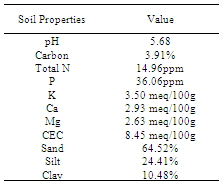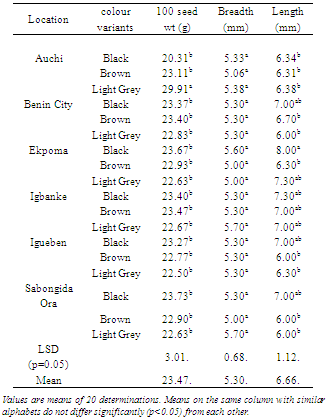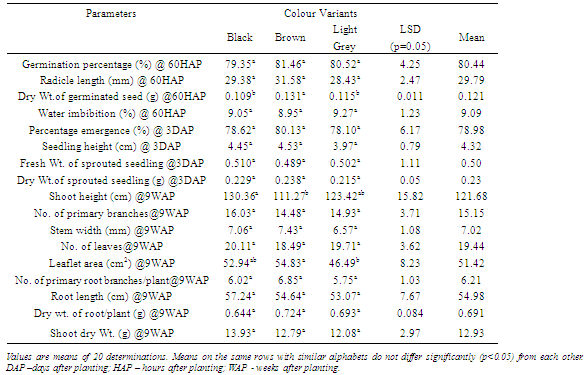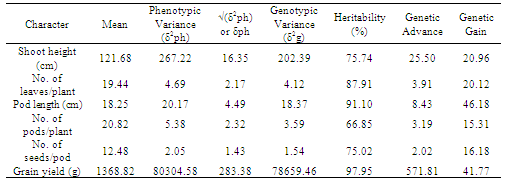-
Paper Information
- Next Paper
- Paper Submission
-
Journal Information
- About This Journal
- Editorial Board
- Current Issue
- Archive
- Author Guidelines
- Contact Us
International Journal of Modern Botany
p-ISSN: 2166-5206 e-ISSN: 2166-5214
2012; 2(2): 13-18
doi: 10.5923/j.ijmb.20120202.01
Genetic Assessment of Three Colour Variants of African Yam Bean[Sphenostylis Stenocarpa] Commonly Grown in the Midwestern Region of Nigeria
Beckley Ikhajiagbe1, Joseph Kwesi Mensah2
1Dept. of Plant Biology and Biotech., University of Benin, Benin City
2Dept. of Botany, Ambrose Alli University, Ekpoma
Correspondence to: Beckley Ikhajiagbe, Dept. of Plant Biology and Biotech., University of Benin, Benin City.
| Email: |  |
Copyright © 2012 Scientific & Academic Publishing. All Rights Reserved.
Three varieties of African yam bean (Sphenostylis stenocarpa) were collected from six different locations in Edo State, Nigeria (Ekpoma, Benin City, Auchi, Igueben, Igbanke and Sabongida Ora). These seeds were then characterized based on seed colour into black, brown, and light grey. The seeds were screened in the field for agronomic and yield associated characters as well as chemical composition of the seeds. Considerable variations were observed in both agronomic and yield associated characters like shoot height, leaf area, grain yield and total ash content of the seeds. The black colour variant was significantly (p<0.05) highest in grain yield per hectare (1542.28kg/ha) compared to both brown variant (1304.23kg/ha) and the light grey type (1259.97kg/ha).
Keywords: African Yam Bean, Agronomy, Heritability, Sphenostylis Stenocarpa
Article Outline
1. Introduction
- Nigeria, like many third world countries is a food deficit country especially with the increasing population growth. Most rural communities cannot afford animal proteins and over three million children lack sufficient proteins within the last decade, and therefore suffer grossly retarded physical growth and development. Protein deficiencies also directly or indirectly affect the health and economic productivity of adult populations[1]. With the ever increasing population pressure and fast depletion of natural resources, it has become necessary to explore the possibilities of exploiting new plant resources to meet the growing needs of the human society, which incidentally has depended only on a small fraction of plant resources comprising less than 30 crops; among which is the African yam bean, a leguminous crop[2]. The African yam bean[Sphenostylis stenocarpa (Hochst. Ex A. Rich) Harms] is a climbing legume adapted to lowland tropical conditions. It is one of the lesser-known legumes[3, 4, 5] and widely cultivated in the southern parts of Nigeria. The legumes are a good source of dietary protein[6]. They are cheaper than animal products such as meat, fish, poultry, egg – therefore they are consumed worldwide as a major source of cheap protein and especially in the developing or poor countries where consumption of animal protein may be limited as a result of economic, social, cultural or religiousfactors[7]. Global food security however is becoming shaky with increasing dependence on a few major staple crops. This has resulted in an alarming reduction not only in crop diversity but also in the variability within crops. This therefore emphasizes the need for the collection and conservation of diversity within species. Usually when this done, there is the possibility for stockpiling crops of converse characteristics - for example, stockpiling low yielding varieties with high yielding ones.
2. Objectives
- Biodiversity of species assures their evolutionary continuity. The collection and conservation of diversity within species is a safeguard against the loss of germplasm. They provide a buffer against environmental threats and assure continual and sustainable productivity. This is particularly achievable when the traits of these diverse species are documented as well. In Edo State, for example, a visit round markets in the areas chosen for study (Auchi, Benin City, Ekpoma, Igbanke, Igueben, and Sabongida Ora) show predominance of three colour variants of African yam bean – black, brown, and light grey colours. The present study therefore comparatively assesses some agronomic traits and chemical composition of seeds of three colour variants of African yam bean commonly grown in the Midwestern Region of Nigeria.
3. Materials and Methods
3.1. Planting Materials
- Three varieties of African yam bean were collected from six different locations in Edo State (Auchi, Benin City, Ekpoma, Igbanke, Igueben, and Sabongida Ora). These towns are located in separate Local Government Areas of the State. The seed characteristics were measured and then characterized based on seed colour into black, brown, and light grey. Similar colour variants were pooled together from all the sources, and planted as described below.
3.2. Germination Tests
- Germination tests were carried out on 2 disks of Whitman No.1 filter paper in 9 cm Petri dishes previously moistened with water. Twenty (20) seeds of the various variants were sown in each Petri dish. Seeds observed to have protrusions of the radicle were considered to have germinated[8, 9].
3.3. Cultivation in Wooden Boxes
- Seeds were sterilized by immersing into 2 % sodium hypochlorite for 7 minutes and rinsing repeatedly in distilled water[10]. Seeds were separately germinated in wooden boxes (57 cm x 41 cm x 15 cm) containing a mixture of top soil of known physicochemical property (Table 1) and organic manure in the ratio 2:3. Growth characteristics of the seedlings were taken into record for 3 days. Seedlings were transplanted after 14 days growth, into the field.
|
3.4. Cultivation in the Field
- The plot was cleared and tilled by properly mixing the soil. Mounds were made at a spacing of 60 cm x 30 cm as proposed by Okeleye et al.[11]. Seedlings in the wooden boxes were then transplanted after 14 days growth, into the field of known soil characteristics (Table 2). Each mound received 2 seedlings, amounting to a mean of 55, 000 plant stands per hectare.
3.5. Crop Husbandry
- The plot was weeded thrice before harvest. Although the plants were exposed to the prevailing weather condition (rainy season), water requirements by the crop were supplemented during very dry days by irrigating, each mound with 400ml distilled water beyond sunset. When plants were long enough, they were staked on bamboo poles.
3.6. Parameters Determined
- Shoot height was measured from the soil level to the tip of the plant using a meter rule. Number of shoot branches and number of leaves were counted in situ. Leaf area was determined using the graph sheet method as described by Eze[12]. Chlorophyll content was measured using the method described by Holden[13]. Root length was measured with meter rule after irrigating and carefully uprooting the plants. The number of primary root branches, number of root nodules and weight of ten root nodules were determined. Plant dry weight was determined after drying to constant weight at 70°C. Yield parameters were determined following the methods of IBPGR and ICRISAT[14]. Proximate and mineral analyses of dry harvested seeds were separately determined by using standard procedures of AOAC[15] and IITA[16]. Parameters include crude protein, crude fibre, ether extract, total ash and dry matter.
3.7. Genetic Studies
- The genetic analysis was done on those parameters related to the variations in the colour of the beans. The mean squares at the treatment levels were taken as the phenotypic variance. Genotypic variance, which is the proportion of the phenotypic variance caused by variations in genes, the mean square at the error level, was subtracted from the corresponding phenotypic variance for all treatments used. The genetic parameters were as follows;Heritability (%) =
 Where δ2g = Genotypic variance, and δ2ph = Phenotypic varianceGenetic advance =
Where δ2g = Genotypic variance, and δ2ph = Phenotypic varianceGenetic advance =  Where k = 2.06 (selection differential at 10%).Genetic gain was calculated in terms of the genetic advance expressed as a percentage of the population mean.
Where k = 2.06 (selection differential at 10%).Genetic gain was calculated in terms of the genetic advance expressed as a percentage of the population mean.3.8. Experimental Design
- The experimental design adopted was the completely randomized design (CRD) following assumption of homogeneity of the experimental plot in use. As a result, treatments were randomized over the whole plot. Each treatment consisted of 20 replicates. The results were presented as mean values. Data was analyzed using the SPSS-16 Statistical Software. A probability of 0.05 was considered as significant.
4. Results and Discussions
- The seed characteristics used in the present study were measured and then characterized based on seed colour into black, brown, and light grey. Table 2 shows the seed characteristics of African yam bean collected from Edo State. Significant variations among the seeds collected for the present study were in the colour; no significant differences were recorded in seeds size, similar to findings by Beridize et al.,[17].
|
|
|
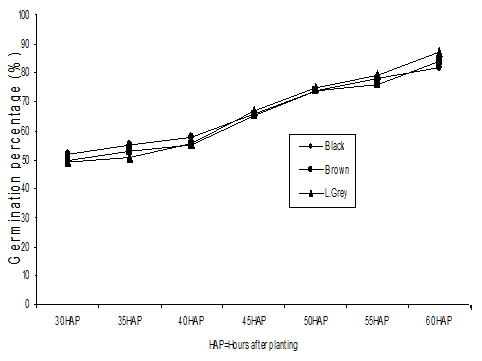 | Figure 1. Comparison of percentage of germination of the three colour variants of African yam bean grown in Edo State |
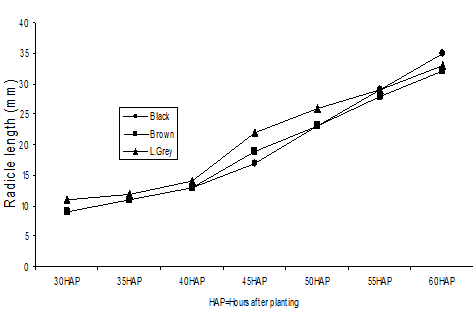 | Figure 2. Comparison of radicle lenths of the three colour variants of African yam bean grown in Edo State |
|
|
 Abstract
Abstract Reference
Reference Full-Text PDF
Full-Text PDF Full-Text HTML
Full-Text HTML